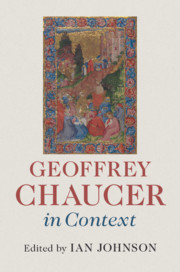Book contents
- Geoffrey Chaucer in Context
- Geoffrey Chaucer in Context
- Copyright page
- Contents
- Illustrations
- Contributors
- Abbreviations
- Introduction
- Part I Chaucer as Context
- Part II Books, Discourse and Traditions
- Chapter 3 Chaucer’s Linguistic Invention
- Chapter 4 Chaucer and London English
- Chapter 5 Manuscripts and Manuscript Culture
- Chapter 6 Chaucer’s Books
- Chapter 7 Authority
- Chapter 8 Literary Theory and Literary Roles
- Chapter 9 Metre and Versification
- Chapter 10 Dialogue
- Chapter 11 Romance
- Chapter 12 Love
- Chapter 13 Chaucer and the Classics
- Chapter 14 The French Context
- Chapter 15 The Italian Tradition
- Chapter 16 The English Context
- Chapter 17 Chaucer’s Competitors
- Chapter 18 Boethius
- Part III Humans, the World and Beyond
- Part IV Culture, Learning and Disciplines
- Part V Political and Social Contexts
- Part VI Chaucer Traditions
- Further Reading
- Index
Chapter 4 - Chaucer and London English
from Part II - Books, Discourse and Traditions
Published online by Cambridge University Press: 24 June 2019
- Geoffrey Chaucer in Context
- Geoffrey Chaucer in Context
- Copyright page
- Contents
- Illustrations
- Contributors
- Abbreviations
- Introduction
- Part I Chaucer as Context
- Part II Books, Discourse and Traditions
- Chapter 3 Chaucer’s Linguistic Invention
- Chapter 4 Chaucer and London English
- Chapter 5 Manuscripts and Manuscript Culture
- Chapter 6 Chaucer’s Books
- Chapter 7 Authority
- Chapter 8 Literary Theory and Literary Roles
- Chapter 9 Metre and Versification
- Chapter 10 Dialogue
- Chapter 11 Romance
- Chapter 12 Love
- Chapter 13 Chaucer and the Classics
- Chapter 14 The French Context
- Chapter 15 The Italian Tradition
- Chapter 16 The English Context
- Chapter 17 Chaucer’s Competitors
- Chapter 18 Boethius
- Part III Humans, the World and Beyond
- Part IV Culture, Learning and Disciplines
- Part V Political and Social Contexts
- Part VI Chaucer Traditions
- Further Reading
- Index
Summary
Chaucer’s London, with a population of around 50,000, had experienced considerable immigration from the Home Counties, Midlands and elsewhere in England in the fourteenth century. In addition to accommodating such incomers, Londoners would also regularly come across Scots, Welsh, Irish, Flemings, Florentines, and Hanseatics. This was, then, a city of multiple identities and shifting linguistic variety. Variation and change therefore characterised London texts and the development of London English during the late medieval period. Chaucer was particularly sensitive to such variation – to geographical distinctions and to emerging social differences articulated linguistically: this shows in his appreciation of the position of French in England as well as of the various ‘Englishes’ that he would have encountered. Chaucer’s verse reveals a writer exceptionally aware of the languages around him, whether he is contrasting the Knight with the Miller, or re-performing Northern speech in his Reeve’s Tale. All in all, the rich range of socio-linguistic usages available in the language of London gave Chaucer numerous opportunities for the literary invention that typifies his achievement.
- Type
- Chapter
- Information
- Geoffrey Chaucer in Context , pp. 35 - 42Publisher: Cambridge University PressPrint publication year: 2019
- 1
- Cited by

